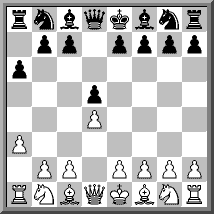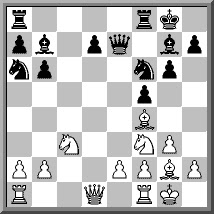1.a3 a6 2.e4 (Dia)
 In some ways this position is not so different from the one arising after 1.e4. However, when you consider that the three most trusted lines in top-level chess is the Najdorf (1.e4 c5 2.Nf3 d6 3.d4 cxd4 4.Nxd4 Nf6 5.Nc3 a6), the Closed Ruy Lopez (1.e4 e5 2.Nf3 Nc6 3.Bb5 a6 4.Ba4 Nf6 5.0-0 Be7) and the Sveshnikov (1.e4 c5 2.Nf3 Nc6 3.d4 cxd4 4.Nxd4 Nf6 5.Nc3 e5 6.Ndb5 d6 7.Bg5 a6 8.Na3 b5) it becomes apparent that there are major differences. Of the ‘big’ openings only the Petroff (1.e4 e5 2.Nf3 Nf6) seems relatively unaffected.
In some ways this position is not so different from the one arising after 1.e4. However, when you consider that the three most trusted lines in top-level chess is the Najdorf (1.e4 c5 2.Nf3 d6 3.d4 cxd4 4.Nxd4 Nf6 5.Nc3 a6), the Closed Ruy Lopez (1.e4 e5 2.Nf3 Nc6 3.Bb5 a6 4.Ba4 Nf6 5.0-0 Be7) and the Sveshnikov (1.e4 c5 2.Nf3 Nc6 3.d4 cxd4 4.Nxd4 Nf6 5.Nc3 e5 6.Ndb5 d6 7.Bg5 a6 8.Na3 b5) it becomes apparent that there are major differences. Of the ‘big’ openings only the Petroff (1.e4 e5 2.Nf3 Nf6) seems relatively unaffected.2...e6!?
At first this seemed to me like Black’s best option. Now it probably will be something resembling a French Defence - a serious opening where Black frequently plays an early ...a6. And just as important: an opening where I couldn’t recall many lines where White plays an early a3. There are however several interesting alternatives:
a) 2...b5!? is the St. George Opening (1.e4 a6) where a3 seems more or less like a wasted tempo. However, after 3.d4 Bb7 4.Nc3 the move after all stops ...b4 as well as some ...Bb4 ideas and White has a grip on the centre.
b) I suppose it will be hard to find a line for Black where ...a6 is useful in the Alekhine. After 2...Nf6?! I believe White should go for the whole hog with 3.e5 Nd5 4.d4 d6 5.c4 Nb6 6.f4 where a3 stops some potential counter-play with ...Bb4 or even ...Nb4.
c) The pseudo-Nimzowitsch arising after 2...Nc6!? could well be one of Black’s best options:
c1) 3.Nf3 d5!? (for 3...e5 see the entry on the ...a6 Mengarini) 4.exd5 Qxd5 and now 5.Nc3 Qa5 seems rather comfortable for Black who can develop quickly with ...Bg4 and ...0-0-0. So possibly 5.Be2, planning c4 and d4 is a better try.
c2) 3.d4 d5 and after the normal-looking 4.Nc3 Black’s best may be 4...dxe5 but I would be inclined to try 4...e5!, which is borderline playable even without a3 and ...a6 included and seems relatively safe with all Bb5 lines eliminated.
d) 2...d5 3.exd5 Qxd5 is a pseudo-Scandinavian:
d1) 4.Nc3 Qd6! should be very comfortable for Black as one of his main systems involves ...a6 while I never have seen anybody play an early a3 in these lines.
d2) 4.d4 is a more interesting try as a3 can indeed be useful in the quiet lines arising from 4...e5 (4...Nc6!?) 5.dxe5 (5.Nf3) 5...Qxd1+ 6.Kxd1. The continuation 6...Nc6 7.Bf4 Bf5 8.Nf3 0–0–0+ 9.Bd3 Nge7 (9...Bxd3 10.cxd3 Rxd3+ 11.Kc2 Rd7 =) 10.Ke2 Bxd3+ 11.cxd3 Ng6 12.Bg3 Bc5 with a small advantage to Black in Llapasset-Chatalbashev, Figueres 2006 is worth noting if only because it’s an example of a 2500+ player meeting 1.a3 with 1...a6.
e) 2...c5, leading to Sicilian waters cannot be a bad move but for some time now, 1.e4 c5 2.a3 has been a relatively popular anti-Sicilian line, and from that move-order 2...a6 doesn’t make much sense. Nevertheless there are a few examples to be found:
3.b4 e6 4.Bb2 (4.bxc5 Bxc5 5.d4 Be7 6.c4 b5 7.Bb2 d6 8.cxb5 Nf6 9.Nd2 gave White a clear advantage in Twitchell-Burton, Birmingham 2006) 4...Nf6 5.e5 Nd5 6.c4 Nf4 7.bxc5 Bxc5 8.d4 Ba7 9.Qd2 Ng6 10.Nf3 Nc6 11.h4 b6 12.h5 and White was clearly better in Korostenski-Orel, Tabor 2005.
3.d4 d5 (Dia)
 3...c5!? may be best. It would resemble the Franco-Sicilian (1.e4 e6 2.d4 c5?!), which is considered slightly suspect because White after 3.d5 holds a space advantage. However, in this set-up an early ...a6 seems considerably more useful than a3 and after 4.d5, the immediate 4...b5 looks reasonable. My try with White would be 4.c3 with the possibility to transpose to our mainline after 4...d5 5.e5.
3...c5!? may be best. It would resemble the Franco-Sicilian (1.e4 e6 2.d4 c5?!), which is considered slightly suspect because White after 3.d5 holds a space advantage. However, in this set-up an early ...a6 seems considerably more useful than a3 and after 4.d5, the immediate 4...b5 looks reasonable. My try with White would be 4.c3 with the possibility to transpose to our mainline after 4...d5 5.e5.4.e5!
This must the way for White to make sense of a3.
a) 4.Nd2 seems rather pointless as ...a6 is a useful move for Black in the Tarrasch-variation (actually 3...a6 is steadily becoming more popular) while I am unable to recall any major variations where White plays an early a3.
b) 4.Nc3 was my immediate try for White - possibly because I knew a few rather strong players had met Prie’s 1.e4 e6 2.d4 d5 3.Nc3 a6!? with the seemingly harmless 4.a3?!
b1) 4...dxe4 5.Nxe4 Be7 6.Nf3 Nf6 7.Bd3 Nxe4 8.Bxe4 c5 9.0–0 Nd7 10.c4 += Lanka-Prie, Paris 1990.
b2) 4...Nf6 5.e5 Nfd7 6.Nf3 c5 7.dxc5 Bxc5 8.Bd3 Nc6 9.Bf4 Be7 10.0–0 0–0 11.Qe2 Nc5 = Guseinov-Radjabov, Moscow 1997.
b3) 4...Nc6 5.Nf3 Nf6 6.Bd3 dxe4 7.Nxe4 Be7 (7...Nxd4?? 8.Nxd4 Qxd4 9.Bb5+ +- Grillo-Mussap, Salsomaggiore Terme 2005) 8.0–0 0–0 9.c3 b6 10.Nfg5 Nxe4 11.Bxe4 Bxg5 12.Bxc6 += Garcia Vasquez-R.Gomez, Bogota 2004.
4...c5!?
Maybe 4...Bd7! is a simpler solution. It seems to compare favourably with the variation 1.e4 e6 2.d4 d5 3.e5 Bd7 4.Nf3 a6, planning ...Bb5, but is it sufficient for equality?
5.c3 Nc6 6.Nf3 (Dia)
 This French position has actually more frequently appeared from the Sicilian move-order 1.e4 c5 2.Nf3 a6 (the O’Kelly-variation) 3.c3 e6 4.d4 d5 5.e5 Nc6 6.a3.
This French position has actually more frequently appeared from the Sicilian move-order 1.e4 c5 2.Nf3 a6 (the O’Kelly-variation) 3.c3 e6 4.d4 d5 5.e5 Nc6 6.a3.6...Bd7!
Other moves fail to make sense of ...a6:
a) 6...c4 7.Bf4 (It’s worth reminding of the old trap/error 7.Nbd2 Qb6 8.Be2 Nge7? 9.Bxc4!) 7...f5 8.exf6 Nxf6 9.Nbd2 Bd6 10.Bxd6 Qxd6 11.Be2 0–0 12.0–0 b5 13.Re1 += G.Lee-Joksic, Biel 1991.
b) 6...Qb6 7.b4 cxd4 8.cxd4 Bd7 (8...Nge7 9.Bd3 Nf5 10.Bxf5 exf5 11.Nc3 Be6 12.0–0 Be7 13.Na4 Qa7 14.Nc5 b6 15.Nb3 h6 16.Ne1 0–0 = Lukianenko-Kuzuev, Moscow 1997) 9.Be3 Rc8 10.Bd3 Nge7 11.0–0 Nf5 12.Qd2 Be7 13.Nc3 Nxe3 14.fxe3 0–0 15.Na4 Qd8 16.Nc5 += A.Zaitsev-Potapov, Kaluga 2003.
7.b4
White has also tried:
a) 7.Be3 c4 8.Nbd2 Na5 9.Be2 Bc6 10.0–0 Qd7 11.Ng5 Ba4 12.Qb1 h6 13.Nh3 0–0–0 14.Nf4 Kb8 15.Bg4 Ne7 unclear Palos-Eingorn, Graz 1995.
b) 7.Bd3 cxd4 8.cxd4 Qb6 9.Bc2 Rc8 10.0–0 Nge7 11.Nc3 Na7 12.Rb1 Nb5 13.Ne2 h6 14.h4 Nc6 15.Be3 Na5 16.Nf4 Nc4 17.Nh5 Kd8 18.Bd3 Rc7 19.Qe2 Kc8 20.Rfc1 Nxe3 21.fxe3 Kb8 22.Qd1 += Iuldachev-Kotronias, Mumbai 2003.
c) 7.Be2 Rc8 8.0–0 h6 9.b4 cxd4 10.cxd4 Na7! (this is the key manoeuvre) 11.Bb2 Bb5 12.Nc3 Bxe2 13.Nxe2 Ne7 14.Qd3 Ng6 15.Nd2 Qd7 16.Rac1 Be7 17.Nb3 Rxc1 18.Rxc1 0–0 19.g3 Rb8 20.h4 Qb5 21.Qe3 Nc8 22.Nc3 Qe8 23.Kg2 Nb6 =+ Sadvakasov-Morozevich, Mainz rapid 2004. 7...cxd4
7...c4 also fails to make sense of ...a6 8.Be2 Nge7 9.Nbd2 Nf5 10.Nf1 Be7 11.Ng3 b5 12.Nxf5 exf5 13.h4 Be6 14.Bg5 h6 15.Bf4 a5 =+ Kozakov-Przybylka, Zabrzanski Wrzesien 1994.
8.cxd4 Rc8 9.Nbd2? (Dia)

9...Bxb4!
Black’s plan - besides completing his development - is to exchange his light-squared bishop by means of ...Na7 followed by ...Bb5. But the most important thing in chess is to strike immediately when opportunity arises.
10.Bb2
My computer suggests that after 10.axb4 Nxb4 11.Rb1 Nc2+ 12.Ke2, Black should play 12...Qa5, when one possible line is 13.Ne1 Nxd4+ 14.Ke3 Ba4 15.Qh5 Nf5+ 16.Ke2 Bb5+ 17.Kd1 Qa4+ 18.Nb3 Bxf1 19.Rxf1 Rc3 with an easy win for Black.
10...Bxd2+ 11.Qxd2 Nge7 12.Bd3 Na5 13.Qg5 Ng6 14.Rc1 Qxg5 15.Rxc8+ Ke7!
Quite a rare intermediate move; in Watzka-Karayannis, Chalkidiki 2002 White resigned. Not at all an unreasonable decision considering that Black will be at least two connected pawns up in an semi-endgame. But no game has been won by resigning, and I believe I would have tried 16.Rxh8?! Qxg2 17.Rg1 Qxf3 18.Bc3 with the faint hope of getting in the cheapo 18...Qxd3?? 19.Bb4 mate!





























